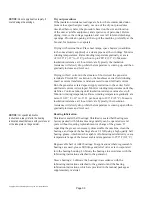
Page 33
Copyright © 2012 Kato Engineering, Inc. All rights reserved
WARNING: When using cleaning
solvents, ensure adequate ventilation and
user protection. Inhaling vapors may impair
breathing and/or cause damage to internal
organs.
Deterioration or degradation of insulation from thermal aging:
Examination of coils reveal general puffi ness, swelling into ventilation
ducts, or a lack of fi rmness of the insulation, suggesting a loss of bond
with consequent separation of the insulation layers from themselves or
from the winding conductors or turns.
Abrasion: Abrasion or contamination from other sources, such as
chemicals and abrasive or conducting substances, may damage coil and
connection surfaces.
Cracking: Cracking or abrasion of insulation may result from prolonged
or abnormal mechanical stress. In stator windings, looseness of the
bracing structure is a certain sign of such phenomena and can itself cause
further mechanical or electrical damage if allowed to go unchecked.
Erosion: Foreign substances impinging against coil insulation surfaces
may cause erosion.
Cleaning
Exterior: Wipe loose dirt from the exterior with a clean, lint-free cloth.
Remove stubborn accumulations of dirt with a detergent or solvent
that won’t damage the paint or metal surfaces. Use a vacuum to clean
ventilating ports.
Windings, assembled machines: Where cleaning is required at the
installation site and complete disassembly of the machine is unnecessary
or not feasible, pick up dry dirt, dust or carbon with a vacuum cleaner to
prevent the redistribution of the contaminant. A small non-conducting
nozzle or tube connected to the vacuum cleaner may be required to reach
dusty surfaces or to enter into narrow openings. After most of the dust
has been removed, a small brush can be affi xed to the vacuum nozzle to
loosen and allow removal of dirt that is more fi rmly attached.
After the initial cleaning with a vacuum, compressed air may be used to
remove the remaining dust and dirt. Compressed air used for cleaning
must be clean and free of moisture or oil. Air pressure or velocity must
be adequately controlled to prevent mechanical damage to the insulation.
Disassembly of the machine and more effective cleaning by a qualifi ed
Kato technician may be required if the above described fi eld service
cleaning procedures do not yield effective results.
Windings, disassembled machines: Take an initial insulation resistance
reading on the machine to check electrical integrity. The high pressure
hot water wash method of cleaning, which sprays a high velocity jet of
hot water and water containing a mild detergent, is normally effective
in cleaning windings, including those subjected to fl ooding or salt
contamination.
















































